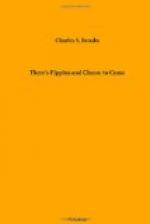The Edinburgh Review was founded in 1802, the Quarterly Review in 1809, Blackwood’s Magazine in 1817. These three won distinction among others of less importance, and from them only I quote. In 1802, when Tory rule was strongest and Lord Eldon flourished, there was living in Edinburgh a group of young men who were for the most part briefless barristers. Their case was worse because they were Whigs. Few cases came their way and no offices. These young men were Francis Jeffrey, Francis Horner, Henry Brougham, and there was also Sydney Smith who had just come to Edinburgh from an English country parish. The eldest was thirty-one, the youngest twenty-three. Although all of them had brilliant lives before them, not one of them had made as yet more than a step toward his accomplishment. Sydney Smith had been but lately an obscure curate, buried in the middle of Salisbury Plain, away from all contact with the world. Francis Jeffrey had been a hack writer in London, had studied medicine, had sought unsuccessfully a government position in India, had written poor sonnets, and was now lounging with but a scanty occupation in the halls of the law courts. Francis Horner had just come to the Scottish bar straight from his studies. Henry Brougham, who in days to come was to be Lord Chancellor of England and to whose skill in debate the passing of the Great Reform bill of 1832 is partly due, is also just admitted to the practice of the law.
The founding of the Review was casual. These men were accustomed to meet of an evening for general discussion and speculation. It happened one night as they sat together—the place was a garret if legend is to be believed—that Sydney Smith lamented that their discussions came to nothing, for they were all Whigs, all converted to the cause; whereas if they could only bring their opinions to the outside public they could stir opinion. From so slight a root the Review sprouted. Sydney




